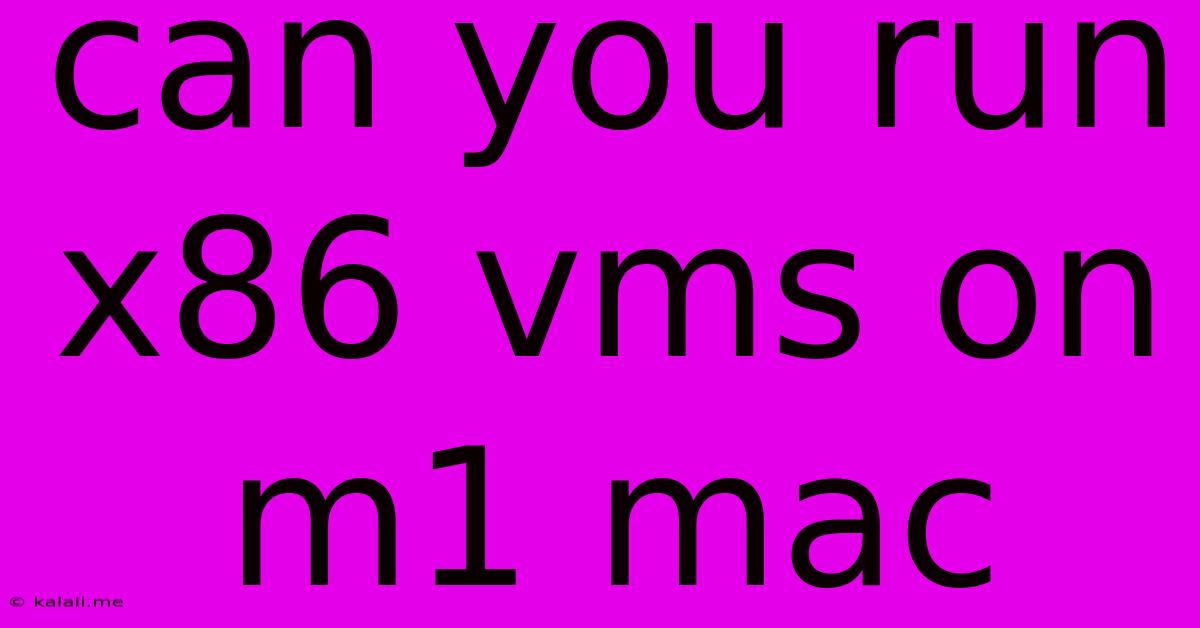Can You Run X86 Vms On M1 Mac
Kalali
May 27, 2025 · 3 min read

Table of Contents
Can You Run x86 VMs on M1 Macs? A Comprehensive Guide
The Apple Silicon transition, spearheaded by the M1 chip, marked a significant shift in Mac architecture. Moving away from Intel's x86 processors to Apple's own ARM-based architecture raised a crucial question for many users: can you run x86 virtual machines (VMs) on M1 Macs? The short answer is: yes, but with some caveats. This article delves into the methods, limitations, and best practices for running x86 VMs on your M1 Mac.
Understanding the Architectural Difference: The core challenge lies in the fundamental difference between x86 and ARM architectures. x86 instructions are designed for Intel and AMD processors, while ARM instructions are optimized for Apple Silicon and other ARM-based chips. Directly running x86 applications on ARM hardware isn't possible without emulation or translation.
Methods for Running x86 VMs on M1 Macs
There are primarily two ways to achieve this:
-
Using Rosetta 2: Apple's Rosetta 2 translation layer is a powerful tool that allows many x86 applications to run natively on M1 Macs. While not a VM solution itself, it plays a vital role in enabling some VM software to function. Rosetta 2 translates x86 instructions into ARM instructions on-the-fly, enabling compatibility. However, performance can be affected, particularly with demanding applications.
-
Virtualization Software with x86 Emulation: Several virtualization platforms offer x86 virtualization capabilities on M1 Macs using emulation techniques. These solutions create a virtual x86 environment within the ARM environment, allowing you to run x86 VMs. This method generally offers better compatibility than relying solely on Rosetta 2, but it usually comes with a performance hit. Popular choices often include Parallels Desktop and VMware Fusion. Both offer robust x86 virtualization for M1 Macs, leveraging advanced emulation techniques to minimize performance overhead.
Performance Considerations: The Trade-off Between Compatibility and Speed
While running x86 VMs on M1 Macs is achievable, it's essential to manage expectations regarding performance. Emulation inherently introduces overhead, leading to slower execution speeds compared to running x86 applications directly on an x86 processor. The performance impact can vary depending on the complexity of the VM and the workload. Resource-intensive applications, such as gaming or video editing within the VM, will likely experience a noticeable performance drop.
You'll observe that lighter applications within the virtual machine will run reasonably well, while graphically demanding programs might struggle. Consider the specific demands of your applications before deciding if virtualization is suitable. If performance is paramount, explore native ARM alternatives whenever possible.
Choosing the Right Virtualization Software: Parallels vs. VMware
Both Parallels Desktop and VMware Fusion provide excellent x86 virtualization support for M1 Macs. The "best" choice depends on individual needs and preferences. Parallels often emphasizes ease of use and seamless integration with macOS, while VMware might be favored for more advanced customization options and features beneficial to experienced users. Both consistently update their software to optimize performance and compatibility with M1 Macs.
Conclusion: A Viable, Though Not Ideal, Solution
Running x86 VMs on M1 Macs is feasible thanks to Rosetta 2 and sophisticated virtualization software. However, remember the performance trade-off. While it offers a bridge for users needing to run legacy x86 applications, it's not a perfect substitute for native ARM performance. The best approach is to utilize native ARM alternatives where available and to resort to virtualization only when strictly necessary for specific x86-dependent software. Always check the specific system requirements and user reviews before purchasing any virtualization software to ensure compatibility and performance expectations align with your use case.
Latest Posts
Latest Posts
-
Do I Need Plumbers Putty For Sink Drain
May 29, 2025
-
How To Remove A Screw That Is Stripped
May 29, 2025
-
Car Not Starting No Clicking Sound
May 29, 2025
-
Ff13 2 Move The Long Gui
May 29, 2025
-
How To Stop Cats Peeing On Rugs
May 29, 2025
Related Post
Thank you for visiting our website which covers about Can You Run X86 Vms On M1 Mac . We hope the information provided has been useful to you. Feel free to contact us if you have any questions or need further assistance. See you next time and don't miss to bookmark.